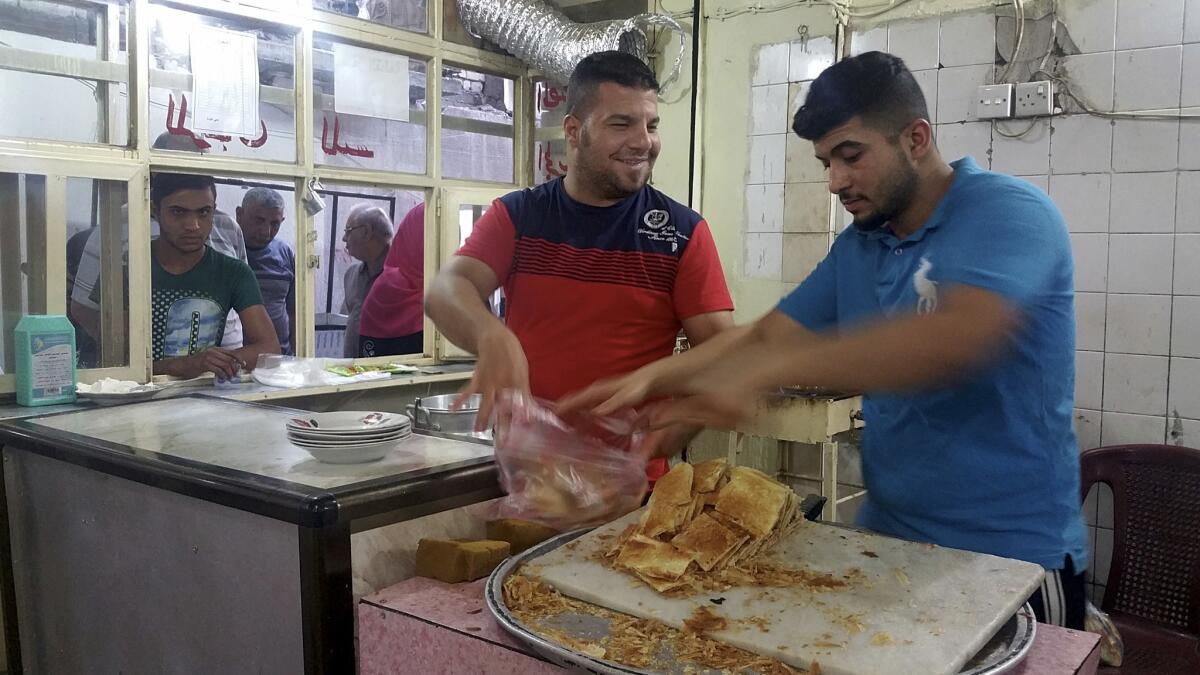On the Ground: Pastry, fat, and perfection: A recipe for Baghdad’s favorite breakfast food

Kahi combines the delicacy of a beautiful Mille Feuille with all the profligacy of a glazed cream donut. However you perceive it, one things is for sure: Iraqis love it. Adore it. Can’t get enough of it.
- Share via
Reporting from Baghdad — It’s 3 a.m. on a Friday, and while most denizens of Baghdad are either winding down the night or ensconced in bed, Hatem Taai and his bleary-eyed crew have just begun their work day.
They assemble in a dingy alley off of Baghdad’s posh Karrada Street. The staffers’ bulky frames, bulging muscles and frowning dispositions give them the air of a particularly menacing band of boxers itching for a street fight.
For the record:
4:30 p.m. Aug. 15, 2016This story originally stated that the cooks use lard, a pork product that is forbidden under Islamic dietary laws. The correct ingredient is ghee, or clarified butter.
But no. The only workout their meat hooks will get will be from pounding and rolling dough to paper-thin rectangles. It’s the prelude to the delicate, quick surgery that lies at the heart of making of kahi, a phyllo-esque pastry that marries the delicate layering of a Parisian mille-feuille with the profligacy of a glazed cream doughnut.
It’s the Iraqi breakfast dish extraordinaire. On any given morning, this unassuming walkway, home of the Kahi of Karrada cafe, becomes a hive of activity, producing hundreds of golden-brown sheets of pastry for hungry Baghdadis who will flock in for a sugar and fat fix.
“It’s the breakfast of the masses. It’s like fast food,” says Taai, owner of the cafe. “Normally, we come in at 4 a.m., but on Fridays and holidays, there’s much more demand, so we come earlier.”

Taai, an avuncular, bespectacled 59-year old man who began working in a bakery when he was 13, said he initially offered cakes and other desserts in his cafe when he first opened in 1988. But he soon eschewed all other pastries and now focuses only on kahi.
“That’s what people wanted more than any other pastry. You wake up in the morning, it’s the natural thing to have it.”
One side of the alley is dominated by large, chest-high tables, where an assembly line is soon in place. The air crackles with the rhythmic patter of rolling pins and dough slapped against a surface.
Hussein Farhan, 32, calmly picks up one edge of a rolled-out hunk of dough; his sausage-like fingers work quickly, deftly making one fold, another, then two more before he neatly stacks the resulting “pouch” in a nearby tray.
His equally massive brother, Ali, takes a pouch and flattens it out to a neat rectangle. He kneels almost tenderly as he carefully places it on another tray. A busboy takes the full tray to the oven for a six-minute bake.
Throughout the process, both Farhaan brothers regularly dunk their hands in the bowls of melted lard arrayed before them – an essential ingredient of kahi.
Even by the dismal health standards of Iraqi food (where the double, nay, the triple starch rule is gleefully ignored and fat is a constant presence in every meal) kahi is bad news.
“Ghee… oil… and butter… oh and milk,” says Hussein haltingly. “We put them [in the kahi] so we get the nice layers.”
Once out of the oven, the kahi comes to the counter of Taai’s 26-year old son, Qusai, who lies in wait with spatula and knife.
“We’re the first kahi place that opened in Karrada,” he boasts, the pastry emitting a satisfying crunch as it yields to the knife. He cuts it into manageable squares, arranging them on a plate in a flower-like pattern before he distributes a splash of cardamom-infused sugar water.
That’s when he turns to geymar, a thick, clotted cream, made from the milk of water buffaloes, for which Iraq, among other countries, is famous.
Although it can be found in stores, most Iraqis prefer to buy it farm-fresh; prune-faced women, swaddled in black Bedouin clothing, camp out on street corners near places where kahi is sold, with large trays of geymar brewing overnight.
A dollop of the stuff is the health equivalent of a hydrogen bomb. Its richness leaves one gasping, even as its scent, redolent of the animal from whence it came, delivers a sneaky sucker punch to the nose.
Qusai heaps the geymar in the center of the kahi flowers. Hungry patrons standing in shambolic lines a few feet behind the shop window stare with almost physical longing at the plates going past.
“It’s better with geymar. It gives it a special taste,” says Ahmad Abdullah, one of the lucky ones already demolishing a kahi plate. He takes a square still dripping with syrup, using it to scoop geymar before he pops it into his mouth.
“Geymar is an Iraqi flavor. You want to try?”
By 9 a.m., customers, some of whom began to show up three hours earlier, begin to trickle out. They leave with an almost shamefaced look of bliss on their faces. Others soon take their place.
But it’s no time to dally for Qusai, as a fresh batch of kahi is put before him.
“By noon we’ll be done,” he sighs as he takes up his knife again.
Bulos is a special correspondent.
More to Read
Sign up for Essential California
The most important California stories and recommendations in your inbox every morning.
You may occasionally receive promotional content from the Los Angeles Times.













